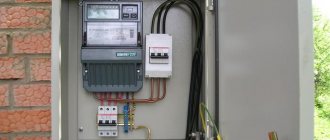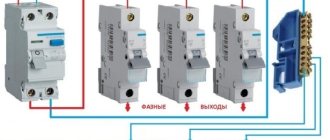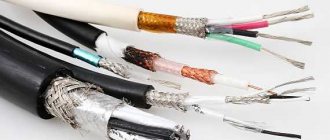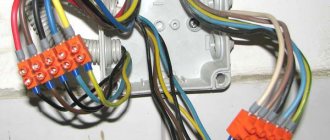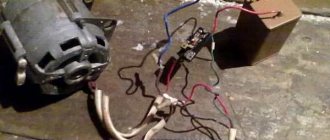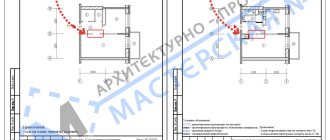How to ground electrical equipment
Next, we will talk about where the protective grounding comes from into our house, and consider its path from the transformer substation and whether it is safe to carry out grounding in the apartment. Such grounding begins with a solidly grounded neutral - connected to the grounding device of the neutral of the power transformer.
The neutral, together with the three-phase line, first enters the input cabinet. From there it is distributed to the electrical panels located on the floors.
The working zero is taken from it, which together with the phase forms the phase voltage that is familiar to us. The name “working zero” is due to the fact that it is used to operate electrical installations or electrical appliances.
A separate protective zero taken from the electrical panel, which has an electrical connection with a solidly grounded neutral, forms a protective zero. It is imperative to know that there should be no switching devices (automatic machines, switches, etc.) or fuses in the circuit of protective grounding conductors.
Every homeowner should know the location of the power supply route.
In most cases, owners resort to searching for a diagram of the location of electrical communications in the house when problems have already arisen.
Meanwhile, you should think about this in other cases:
- Before remodeling your home
During the reconstruction of a room, when changing its configuration, it is necessary to take into account the location of the electrical network so as not to cut off the power to the apartment or house.
- When installing lamps, hanging pictures, shelves or suspended ceilings
When carrying out any wall work, you need to know where the wiring runs so as not to damage it with a nail or drill through it.
Wiring damage often occurs during the installation of suspended ceilings. The corners at which the ceiling is attached are attached to the wall with self-tapping screws, and often these fasteners end up on the electrical wire line.
- After purchasing a home
Every owner must have a circuit diagram. Therefore, it should be drawn up immediately after purchasing a new premises. The plan must indicate the routes of electrical communications and the location of switches, sockets and junction boxes. In the future, the diagram will be useful when arranging furniture and during repairs.
Zero burnout: accident or inevitability
You can deal with electricity problems correctly if you become familiar with zero burnout. If you have heard from your friends the phrase that electrical appliances and expensive equipment burned out in the apartment due to a voltage drop, this means that their power supply is not 220V, but 380V. Where does the 380 Volt voltage in the electrical network come from? Often, this is due to a break in the zero, or, as is customary in the vocabulary of electricians, burnout of the zero. Why does the zero burn out? To understand this, let’s consider in general terms what an electrical network is. An electrical network is a set of electrical installations through which electricity is transmitted and distributed from the power plant to the end consumer.
Preventive measures to prevent short circuits
Most short circuits and the fires they cause can be avoided. To do this, you should follow simple rules:
- Do not overload the electrical wiring with power (current). Select the cable cross-section and lay it in accordance with the requirements of the PUE.
- Periodically inspect the electrical panel, sockets and switches. The smell of burning, smoke, sparking and crackling are harbingers of a short circuit and fire.
- Replace old circuit breakers with new ones. Especially if a revision of the shield has not been carried out since Soviet times.
- If you use fusible plugs at the entrance to the apartment, then under no circumstances place so-called bugs on them. Even if an electrician I know “did this 100 times and everything was fine.” It is best to replace traffic jams with automatic machines.
If you notice that there is a burning smell coming from the electrical panel or switchgear, immediately notify the management company. The actions of the emergency service will be aimed at preventing short circuits and inspecting equipment.
A short circuit is one of those problems that are easier to prevent than to correct the consequences. Any wiring, various devices and panels require periodic inspection by a specialist. Compliance with this rule will ensure long and safe operation of electrical equipment.
If it was not possible to avoid a short circuit, then you need to think about its causes. Wiring that is old, too thin or damaged by animals must be replaced. Damp - dried and further tested by a professional electrician using a megger or more advanced instruments.
What does zero burnout lead to in a three-phase network?
What will change if the neutral wire N breaks BEFORE the junction of the neutral wires at one point? There will be a zero break in a three-phase network:
Zero break in a three-phase network
If you look at the diagram, to the right of the break point the voltage will now not be zero, but “walk” within arbitrary limits.
What happens if the zero is disconnected (accidentally or intentionally)? What voltages will be supplied to consumers instead of 220V? It depends.
The picture in a different form may be easier to understand:
Phase imbalance as a result of zero loss.
Consumers are conventionally shown as resistances R1, R2, R3. The voltages shown in the previous figure are as
220B, designated as
0…380V. I'll explain why.
So, what happens if the zero disappears (the cross in the lower right corner)? In an ideal case, when the electrical resistance of all consumers is the same, nothing will change at all. That is, there will be no phase imbalance. This happens when three-phase consumers are turned on, for example, electric motors or powerful air heaters.
But in real life this never happens. There is no one in one apartment, and only the TV is on in standby mode and the phone is charging. And the neighbors on the site did the laundry, turned on the split system and electric kettle. And then - BANG! - the zero burns out.
Phase imbalance begins. And how brutal it is depends on the real situation.
For neighbors who are at home, the kettle will stop heating, the washing machine and splitter will go out, and the voltage will drop to 50...100V. Because the “resistance” of these neighbors is much lower than that of those who are not at home. And so, these people are quietly working at work, and at this time in their empty apartment their TV and Chinese charger are smoking. Because the voltage in the sockets jumped to 300...350V.
These are real facts and figures, this sometimes happens, the condition of electrical panels on staircases is often disastrous. Even when a major renovation is carried out in the house, the panels are not touched, since changing the electrical system is much more difficult than painting the house and installing new windows.
Such a fire should be investigated not by calling psychics (you never know, a poltergeist is playing with matches;)), but by calling an electrician.
Methods of protection against zero break
To reduce the potential on the neutral conductor and, accordingly, to increase the effective difference between the standard phase voltage of the network and the zero, multiple re-grounding of the combined zero is used. This measure is also intended to reduce the negative consequences for consumers due to a break in the neutral conductor in the power supply network.
The arrow indicates the re-grounding of the zero (PEN) on the overhead line support
Unfortunately, in many provincial regions, especially in rural areas, the re-grounding resistance is insufficient to provide reliable protection against overvoltage that occurs when the neutral wire breaks. In addition, on overhead lines of the power supply network, which predominate in rural areas, zero breaks occur much more often than in urban underground or hidden (protected) power lines.
An ordinary consumer can influence the quality of the power supply at the input only with the help of legal instruments - complaints, petitions, lawsuits, etc. But in a home network, it is possible to maintain an acceptable level of power quality with the help of stabilizers. And you can protect yourself in emergency situations by using voltage relays or automatic devices with additional functions.
Joule-Lenz law
Toki Fuko. Eddy currents and their applications
Let's sum it up
Of course, the probabilities of accidents are random; the most that can be done in such situations is to take the necessary measures to ensure protection. But besides this, it would not be superfluous to identify an emergency situation in time based on its characteristic signs. First of all, the burning out of the neutral main wire leads to network overvoltage. Having discovered the first signs of this phenomenon, you should turn off all electrical appliances.
Doing this quickly and independently is almost impossible. The time period for this is too short, so you should install special devices on the electrical panel that respond to a zero break. As soon as the voltage goes beyond the set limits, the voltage control relay will perform a protective shutdown.
You should not completely trust the security system. It may happen that if there are characteristic signs of voltage surges, a power outage will not occur. Therefore, it makes sense to list the most likely manifestations for this phenomenon:
- Flickering of incandescent lamps . They are most sensitive to the difference in voltage level that occurs when the zero is broken. Energy-efficient lighting fixtures and LED lamps are not as responsive to changes.
- Electronic devices with built-in protection are usually disconnected from the power supply. Or they don't start. Such actions are provided for by the protection response of pulsed power supply units to voltage surges. It is typical that such a reaction can operate earlier than the voltage relay. But this largely depends on the manufacturer and the implementation scheme for protecting electrical networks, as well as the reliability of the electrical connection.
- Another characteristic sign is an increase in the temperature of the switch . Even if you did not pay attention to the flickering of the lamps, this manifestation should cause concern.
- Sparking when trying to connect an electrical appliance may indicate a zero break at the input of a single-phase consumer. Even if it is caused by another factor, and not a zero break, this is a very bad sign.
- Spontaneous operation of input circuit breakers may also indicate overvoltage. This reaction to a zero break is typical when turning on electric heating devices, such as an electric furnace, boiler, kettle, etc.
- Characteristic sounds in the input electrical panel may also indicate voltage drops. In such a situation, it is recommended to turn off the power input and wait for the emergency team to arrive. There is a high probability that a zero-loss accident occurred in the supplier’s power grid.
- a voltage relay at the electrical network input . Ideally, it is advisable to duplicate this system with a voltage stabilizer for a house or apartment. Such a device, working in tandem with a relay, will allow you to maintain a given voltage level without turning off the power.
In fact, only multi-level protection can provide maximum security.
Zero break in a single-phase network
Here the picture will be as follows:
Zero break in a single-phase network
For a load that operates on other phases, nothing will change at all. It’s the same as if you turn off the automatic circuit breakers in your apartment – your neighbors won’t give a damn.
But if a break occurs, for example, in a panel, then the entire apartment, including the broken end of the neutral wire, will be under 220V voltage!
Breakage (burnout) happens because of rusty bolts like those at the top of this photo:
Bad zero. Missing zero in the apartment
I repeat - if the grounding is done correctly, or if there is no grounding at all, this accident is not dangerous in any way. And, of course, you don’t need to touch the wires without waiting for an electrician - they all have deadly potential!
Okay, we understand who is to blame. What to do?
Search procedure
To find a cliff you will need:
- Indicator screwdriver;
- Locator or other device for searching for a break in hidden wiring in the wall;
- Screwdriver;
- Multimeter;
- Pliers;
- Knife with insulated handle;
- Insulating tape.
First of all, you need to define an emergency connection group. If you have a wiring plan, there is nothing complicated about it. If there is a phase on the damaged socket, then by turning the circuit breakers on and off, you can find the wire you are looking for. The presence of a phase is checked by an indicator. The connection group in which a problem is detected should be completely disconnected from the machine, disconnecting all cable cores.
After this, you need to sequentially ring all the connections, starting from the cable in the switchboard to finding the place where the sockets are connected by one wire. If there is access to distribution boxes, they need to be opened. If there are no internal problems, the damaged core is dialed from the connection.
If the boxes are inaccessible or the wiring is done without them, you need to remove the sockets along the entire length of the damaged area and ring through them. Most often, problems arise in the first outlet, since it bears the maximum load. If the damage is not found, then it is inside the wall.
Consequences of a zero break in a three-phase network
I'll tell you stories from my life.
- Electricians were repairing the entrance to the entrance. And during the repair, the working zero was turned off for a few seconds. A very unpleasant thing happened: when people returned home in the evening, they discovered that their TVs, refrigerators, chargers, etc. had burned out. - something that is constantly plugged into our outlets. It's good that there hasn't been a fire yet.
- Came on call, complained - tension was floating. I measure the voltage (everything is turned off) - almost 300 volts. Then, when the incandescent lamp is turned on, the voltage drops to 70V... It turned out that a bolt had burnt out in the floor panel, which received a zero. There was a break in the zero, a phase imbalance, and voltages went wild. I replaced the bolt, restored contact, and the voltage returned to normal.
Scratch bolt. Rusty, does not leak periodically. If you change it without turning it off, 100% of the equipment in the entrance will burn out!
An article on how I changed the electrical panel there is here.
I was called to an advertising and publishing company. According to preliminary estimates, the damage is more than 100 thousand rubles, and all due to poor contact on the zero bus:
Zero burnout from the zero bus
The neutral wire burned off from the second bolt. You can see how it fell off under tension. Before falling off, it ALMOST melted the insulation of the phase wires (vertical, red and white).
The server has not been turned on yet, perhaps the intellectual damage will be greater...
As you can see, such problems occur due to incorrect actions of “electricians” or due to spontaneous breakage (burnout) of the neutral wire in the old housing stock.
In this article I will tell you in detail why this happens and how to deal with it.
What's new in the VK SamElectric.ru group?
Subscribe and read the article further:
Emergency phone numbers on the receipt, example
Single hotline number of IDGC of the South PJSC - Rostovenergo - 8 800-100-70-60
for residents of Rostov-on-Don and the Rostov region.
If you are in another city, you need to act in the same way - look for a specialist via the Internet, newspapers, or call an emergency crew. However, the emergency service will help for free only if the problem occurs before entering the apartment. The rest is for an additional fee.
When you call, try to encourage the electrician to have a frank conversation - in my experience, almost half of the cases are resolved over the phone.
Another piece of advice - if you called a specialist, but after some time the problem somehow went away, take the trouble to call again and tell him not to come. I have had many times when I arrived on call, and everything was already working. And in any case, an electrician will not leave without money)
A house differs from an apartment in two things - the lack of an entrance with neighbors and the ability to view your wires from the pole to the meter. It’s basically the same with neighbors, just walk further to them. And you can inspect your wires for breaks or sparks.
As a result of the article, we can say: “Citizens, do not self-medicate!”
As always, I welcome constructive criticism in the comments. Maybe I missed something?
Causes of zero break
There are quite a few reasons - a break in the neutral at the substation, in house and access panels, inexperience of electricians, lack of maintenance of electrical networks, and so on. The main reason for neutral breakage is poor-quality wire fastening.
If the neutral is weakly fastened, the wire heats up, oxidizes (which increases the resistance of the neutral-to-housing transition) and burns out. It is also possible for the neutral to burn out when using large fuse ratings.
The neutral often breaks due to strong gusts of wind, icing, repair work, etc. As you can see, there are many reasons for the neutral to break. To avoid the consequences of this malfunction, you need to choose the right protection option.
What are the dangers of old electrical wiring in a house?
First of all, there is a fire danger . Secondly, it is a danger to life and health (current up to 36 volts is considered safe for humans). And thirdly, poor outdated electrical wiring means unstable operation and failure of equipment, and breakdown of expensive household and lighting fixtures.
Old aluminum wiring
- Signs of old wiring
- Danger of aluminum wiring
- Twists and junction boxes
- The dangers of old sockets
- Lighting in old houses
- Complete wiring replacement
Causes and consequences of zero loss
People encountered the concept of zero loss relatively recently - in the 90s. Then a huge amount of modern household appliances and equipment appeared on the market, differing from the classical ones in that when such devices with different resistance values were turned on, additional pulse currents were released into the electrical network, which were not compensated at the midpoint. This led to the accumulation of a current exceeding or equal to one of the phases on the neutral conductor, which contributed to the overload of the neutral wire.
The zero burns out mainly in a poorly crimped contact - the so-called weak point.
A zero break can occur if the house has old wiring
The main reasons for zero loss:
- Voltage surge or short circuit;
- Poor quality of wire connections or weak contact;
- Natural damage to power lines;
- Negligence during repair work;
- Old wiring, which, in addition, gets very hot under modern loads.
To determine the location of the damaged conductor, you can use a special tester, with which you can determine the exact position of the break even under a layer of plaster, or use the method of visual inspection of the switchboard in the apartment. Perhaps the reason lies there and is easily eliminated. If a zero break occurs outside the area of your apartment, you should not show initiative and fix the problem yourself. You should immediately contact the appropriate services, which will quickly, competently and without consequences eliminate the cause and protect residents from undesirable consequences.
Troubleshooting
If the problem occurs in the new wiring, the ends of the wire must be connected. The connection is made as follows:
- The phase conductor must be disconnected from the power supply.
- To the left and right of the break point you need to remove the plaster from the wall. Ultimately, you need to release at least 10 cm of wire.
- The ends of the emergency wire must be pulled apart and a hole drilled in the wall for the branch box. The hole is marked with a hammer drill with a crown attachment, and the hole is selected with a chisel.
- Place the box in the prepared hole, secure it with alabaster and insert the wires into it.
- If there is a supply, the ends of the damaged wire are connected to each other according to the color of the insulation and carefully insulated. The connection is made using PPE.
- The box is closed with a lid, the repair area is plastered and the finish is restored.
In some cases, the damaged area must be completely replaced by pulling it through the corrugation using a broaching device.
The procedure for repairing a damaged neutral conductor is slightly different from repairing a phase. The neutral wire is disconnected from the bus and the phase wire is attached to it. After this, all other actions are performed in the same way as when eliminating a phase loss.
Break of the neutral wire in three-phase and single-phase networks
As you know, electric current flows through a closed circuit, doing work. The home electrical network is one of many branches of the global energy supply network. This means that for the operation of household electrical appliances, it is necessary that at least two conductors be connected through which current will flow.
For rational reasons described below, they are called phase and neutral working wires (N). This article explains the function of the working neutral conductor, and describes the problems that arise if an emergency zero break occurs.
Almost all adults know that the neutral conductor of the network, operating in normal mode, does not pose a threat when touched, since there is no voltage on it that is hazardous to health. But this does not mean that no current flows through the zero wire - you need to clearly distinguish between these concepts. In an ideal circuit, the current of the phase and neutral conductors is identical.
Where does the 380V outlet come from when the zero is broken - clearly, accessible, without formulas.
Surely each of you has had household appliances burn out due to overvoltage at least once in your life. At the same time, many have heard that this often happens due to a zero break.
Let's visually, without formulas, vector diagrams, zero point offsets, etc., from the point of view of the average person, try to figure out how the voltage of 380V, instead of the usual 220V, can end up in your sockets.
After all, a logical question really arises: how is it that one of the wires has broken or burned out, but the voltage does not disappear, but becomes even greater.
Understanding this process will be useful to every consumer, so that later there will be no questions about why electricians are trying to “stick” incomprehensible relays costing several thousand rubles into the electrical panel.
To clearly understand the essence of this phenomenon, let's remember the difference between the serial and parallel circuit for connecting electrical receivers.
With a parallel connection, the phase and neutral conductors simultaneously reach all consumers in the circuit. Let's draw a diagram where these consumers are ordinary incandescent light bulbs.
The input voltage is 220V. With this connection, the voltage on each light bulb will be the same, and with a sufficient cross-section of conductors and a low load, it will not differ much from the input one.
In this case, turning off or turning on each light bulb in turn will not greatly affect its values. It is according to this scheme that all sockets in your apartments are connected.
However, if the voltage is the same, the current in the circuit will be different. Its total value is the sum of the currents passing through bulb No. 1 and No. 2.
You can turn on more powerful devices (200W lamps, kettle), and everything will work perfectly.
The serial connection scheme already introduces significant changes. Here the supply conductor (this can be phase or zero) first comes to the first light bulb, and then leaves it to the next one.
Only after this does it return to the input machine or to the general network.
The number of pantographs does not matter, there can be 2,3,4 or more. The main thing is that they are strictly connected one after the other
What will change if you turn on two 100W lamps in series? What will happen is that the voltage on them will drop by about half.
In this case, the total input voltage will be the sum of the voltage drops across lamp No. 1 and lamp No. 2. That is, 110v on one and 110v on the other. By the way, this seemingly disadvantage can be used very cleverly in several ways.
Let me remind you that in a parallel circuit, U was the same everywhere, no matter at what point. Here the current will be the same, while in any part of the electrical circuit I=I1=I2
However, such a situation with a uniform voltage drop will only be observed if all electrical receivers are of the same power. Instead of one 100W lamp, just screw in a 200-watt one, and you will immediately see the difference.
A 100W bulb will have a voltage of 146V and will burn quite brightly. At the same time, a more powerful 200 watt one will barely glow.
This is due to the fact that the voltage drop directly depends on the consumer resistance. On more powerful devices the resistance is low.
Here are approximate data for standard light bulbs designed to operate on a 220V network:
{SOURCE}
3-phase circuit in normal mode
However, the main question remains: how is all this interconnected with zero breakage and overvoltage in sockets? The fact is that the voltage initially comes from the transformer booths of transformer substations and package transformer substations and comes to the switchboard of the house according to a 3-phase circuit, and not according to a single-phase one, as we pictured above.
What is she like? In general, these are four conductors:
- zero
- and three phases A-B-C
Each phase is connected to a separate consumer (apartment, house) or a group of consumers (several apartments in the entrance). At the same time, everyone has a common zero.
Between phase and zero there will be the usual 220V, and between the two phases there will be the same 380V. Under normal conditions, all light bulbs and pantographs work properly.
You can connect different loads of different ratings, this will not cause overvoltage in any way. The current in this circuit flows through each phase, passes through its consumer and leaves through zero.
Scope of application of protective grounding
Protective grounding is used in electrical installations with voltages up to 1 kV:
- — in direct current networks with a grounded midpoint of the source;
- — in single-phase AC electrical networks with a grounded terminal;
- - in three-phase AC power networks with a grounded zero (TN - S system; as a rule, these are networks 660/380, 380/220, 220/127 V);
| Protective grounding is designed to protect against possible electric shock. For example, a situation arose when the insulation inside an electrical installation was damaged and the body of the installation (for example, a washing machine or refrigerator) became energized. In this case, a short circuit current occurs to which the protection (machine or plugs) reacts and instantly disconnects the electrical installation from the network. |
The formation of a single-phase short circuit current circuit (i.e. a short circuit between the neutral and phase protective conductors) occurs in the event of a phase wire shorting to a grounded housing of the electrical consumer. The damaged electrical installation is disconnected from the supply network due to the activation of protection caused by single-phase short circuit current.
To quickly disconnect the electrical installation located, circuit breakers and fuses installed to protect against short circuit currents can be used. Also for this purpose, magnetic starters with built-in thermal protection, contactors with thermal relays are used, which provide overload protection, etc.
What is a zero break?
To fully answer this question, it is necessary to provide examples of the normal operation of a three-phase power supply input circuit. As an example, we will give a simplified version with an input for a floor distribution board.
Scheme 1. Normal operation of the system
As can be seen from the figure, each of the apartments on the floor is powered from a separate phase (L1 - L3) and a common zero. Which forms a phase voltage of 220 volts (L1N=L2N=L3=220 V) in the household network of each apartment. In this case, a TN-CS power supply circuit is used, where a PE grounding bus is used, connected to the neutral in the building switchgear. The above system is balanced, since the load current in the phase wires is summed through the zero line, which reduces the likelihood of phase voltage imbalance.
Note that it is quite difficult to completely eliminate this phenomenon, since the load resistance at each phase may vary. For example, in apartment_1 the air conditioner and washing machine are turned on, in apartment_2 the owner turned on the boiler and electric stove, and in apartment_3 there are no residents and all household appliances are unplugged. As a result, voltage asymmetry will occur in a three-phase power system.
Now let's look at the network operation in abnormal mode, when the zero burns out.
Features of the neutral wire of a three-phase network
In industry, the electrical network can be assembled in a “triangle” or “star” configuration. For the needs of the population, a star network with a neutral conductor is used. As you know, the three phases of a three-phase network are shifted relative to each other by 120. In the neutral conductor, the currents shifted by 120 are mutually compensated.
Star load connection diagram
With the same load in each phase, the total current of the neutral wire will be zero. This is ideal. In reality, the load of each phase is different, because all load consumers in an apartment building are switched on uncoordinatedly, at different times and with different power.
Therefore, the currents in a three-phase network in the neutral wire will differ from zero. But still, for a 50 Hz network, the current in the neutral wire will be lower than the currents in the phase wires. Therefore, for three-phase 50 Hz networks, the cross-section of the neutral wire is taken to be 2 times lower than the phase wire. Such features of the network can be attributed to past years.
Phase imbalance in a three-phase network, the neutral wire current is not zero
What has changed in the modern power grid? With the advent of technology using switching power supplies, higher harmonics began to be present in the network in addition to the frequency of 50 Hz. If previously only linear loads (heating elements, motors, incandescent lamps) were connected to the network, now non-linear loads with a pulsed power supply have also been added.
All pulse sources have diode bridges with capacitors that periodically change their resistance (turning on and off) with the frequency of the pulse generator. Thus, when a pulsed source operates, short pulses appear in the network. The presence of these short pulses causes a number of negative consequences.
